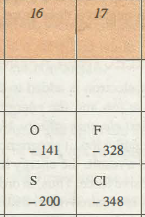Question #9ce3c
2 Answers
Definition: Electron gain is the amount of energy released when one mole of electron is added to a gaseous atom.
Explanation:
Both F and Cl are found in the same Group VII, so they have the same number of 7 valence electrons. As Cl is below F in the Group, Cl has one more electron shell than F, hence Cl has a larger atomic nucleus, so the distance between the nucleus and valence shell (where the gained electron will be at) is smaller in F as compared to that in Cl. This suggests that in Chlorine, the forces of attraction from the nucleus to the gained electron is lower, and as bond forming is exothermic, less energy is given out in the forming of bonds between the nucleus and the electron.
Therefore, electron gain enthalpy in Cl is lower than that in F.
The reason is that
Explanation:
Electron gain enthalpy (
#color(blue)("X(g) + e"^"-" → "X"^"-""(g)")#
- the electronegativity of
#"X"# , i.e., its attraction for incoming electrons - the environment into which the electron enters.
However,
It has a higher electron density, so there will be a greater repulsion of the incoming electron.
In a
The result is that

(Adapted from chemistry Assignment)
We see the same effect with


